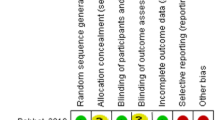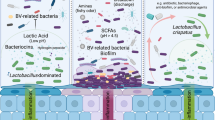Abstract
Purpose
Bacterial vaginosis (BV) is one of the most common vaginal complaints of women of reproductive age, characterized by a shift from a Lactobacillus-dominated vaginal microbiome towards a more diverse flora of facultative and obligately anaerobic bacteria. BV can increase the risk of preterm births, contracting sexually transmitted infections and developing other chronic health issues. Standard treatment for BV are antibiotics, however despite initial efficacy, they do not provide effective long-term treatment and recurrence or persistence prevention. This systematic review focuses on describing the current study situation and summarizing the newest data on the efficacy of alternative non-antibiotic options, namely probiotic products containing lactobacilli, lactic acid, sucrose gel, combination products with estriol, and supplementation of antibiotics.
Methods
We conducted a systematic literature search using the MEDLINE database and evaluated the 33 trials which met our inclusion criteria.
Conclusion
The diverse study designs produced extremely varied outcomes, but so far the results are promising. Furthermore, these alternatives have shown little to no adverse effects and are consequently generally considered safe to use. In general, the results of this review warrant more thorough trials with larger cohort sizes to provide sufficient evidence for these alternatives to be a part of official treatment recommendations.
Similar content being viewed by others
References
Lamont R, Sobel J, Akins R et al (2011) The vaginal microbiome: new information about genital tract flora using molecular based techniques. BJOG 118(5):533–549. https://doi.org/10.1111/j.1471-0528.2010.02840.x
Petrova MI, Lievens E, Malik S, Imholz N, Lebeer S (2015) Lactobacillus species as biomarkers and agents that can promote various aspects of vaginal health. Front Physiol. https://doi.org/10.3389/fphys.2015.00081
Ling XZ, Kong MJ, Liu F et al (2010) Molecular analysis of the diversity of vaginal microbiota associated with bacterial vaginosis. BMC Genomics 11(1):488. https://doi.org/10.1186/1471-2164-11-488
Kenyon C, Colebunders R, Crucitti T (2013) The global epidemiology of bacterial vaginosis: a systematic review. Am J Obstet Gynecol 209(6):505–523. https://doi.org/10.1016/j.ajog.2013.05.006
Amsel R, Totten PA, Spiegel CA, Chen KCS, Eschenbach D, Holmes KK (1983) Nonspecific vaginitis. Diagnostic criteria and microbial and epidemiologic associations. Am J Med 74(1):14–22. https://doi.org/10.1016/0002-9343(83)91112-9
Nugent RP, Krohn MA, Hillier SL (1991) Reliability of diagnosing bacterial vaginosis is improved by a standardized method of gram stain interpretation. Journal of clinical microbiology. 29(2):297–301. https://www.ncbi.nlm.nih.gov/pubmed/1706728. Accessed March 13, 2020.
Nasioudis D, Linhares I, Ledger W, Witkin S (2017) Bacterial vaginosis: a critical analysis of current knowledge. BJOG 124(1):61–69. https://doi.org/10.1111/1471-0528.14209
Onderdonk AB, Delaney ML, Fichorova RN (2016) The human microbiome during bacterial vaginosis. Clin Microbiol Rev 29(2):223–238. https://doi.org/10.1128/CMR.00075-15
Coudray MS, Madhivanan P (2020) Bacterial vaginosis—A brief synopsis of the literature. Eur J Obstet Gynecol Reprod Biol 245:143–148. https://doi.org/10.1016/j.ejogrb.2019.12.035
Sherrard J, Wilson J, Donders G, Mendling W, Jensen JS (2018) 2018 European (IUSTI/WHO) International Union against sexually transmitted infections (IUSTI) World Health Organisation (WHO) guideline on the management of vaginal discharge. Int J STD AIDS 29(13):1258–1272. https://doi.org/10.1177/0956462418785451
Bradshaw CS, Morton AN, Hocking J et al (2006) High recurrence rates of bacterial vaginosis over the course of 12 months after oral metronidazole therapy and factors associated with recurrence. J Infect Dis 193(11):1478–1486. https://doi.org/10.1086/503780
Kenyon CR, Osbak K (2014) Recent progress in understanding the epidemiology of bacterial vaginosis. Curr Opin Obstet Gynecol 26(6):448–454. https://doi.org/10.1097/GCO.0000000000000112
Marrazzo JM, Cook RL, Wiesenfeld HC et al (2006) Women’s satisfaction with an intravaginal lactobacillus capsule for the treatment of bacterial vaginosis. J Women’s Health 15(9):1053–1060. https://doi.org/10.1089/jwh.2006.15.1053
Vujic G, Jajac Knez A, Despot Stefanovic V, Kuzmic VV (2013) Efficacy of orally applied probiotic capsules for bacterial vaginosis and other vaginal infections: a double-blind, randomized, placebo-controlled study. Eur J Obstet Gynecol Reprod Biol 168(1):75–79. https://doi.org/10.1016/j.ejogrb.2012.12.031
Vicariotto F, Mogna L, del Piano M (2014) Effectiveness of the two microorganisms lactobacillus fermentum LF15 and lactobacillus plantarum LP01, formulated in slow-release vaginal tablets, in women affected by bacterial vaginosis. J Clin Gastroenterol 48:S106–S112. https://doi.org/10.1097/MCG.0000000000000226
Mastromarino P, Macchia S, Meggiorini L et al (2009) Effectiveness of lactobacillus-containing vaginal tablets in the treatment of symptomatic bacterial vaginosis. Clin Microbiol Infect 15(1):67–74. https://doi.org/10.1111/j.1469-0691.2008.02112.x
Hallén A, Jarstrand C, Påhlson C. Treatment of bacterial vaginosis with lactobacilli. Sexually transmitted diseases. 19(3):146–148. https://www.ncbi.nlm.nih.gov/pubmed/1523530. Accessed July 11, 2019.
Ling Z, Liu X, Chen W et al (2013) The restoration of the vaginal microbiota after treatment for bacterial vaginosis with metronidazole or probiotics. Microb Ecol 65(3):773–780. https://doi.org/10.1007/s00248-012-0154-3
Anukam KC, Osazuwa E, Osemene GI, Ehigiagbe F, Bruce AW, Reid G (2006) Clinical study comparing probiotic lactobacillus GR-1 and RC-14 with metronidazole vaginal gel to treat symptomatic bacterial vaginosis. Microbes Infect 8(12–13):2772–2776. https://doi.org/10.1016/j.micinf.2006.08.008
Wewalka G, Stary A, Bosse B, Duerr HE, Reimer K (2002) Efficacy of povidone-iodine vaginal suppositories in the treatment of bacterial vaginosis. Dermatology 204(1):79–85. https://doi.org/10.1159/000057731
Hemalatha R, Mastromarino P, Ramalaxmi BA, Balakrishna N, v., Sesikeran B, (2012) Effectiveness of vaginal tablets containing lactobacilli versus pH tablets on vaginal health and inflammatory cytokines: a randomized, double-blind study. Eur J Clin Microbiol Infect Dis 31(11):3097–3105. https://doi.org/10.1007/s10096-012-1671-1
Fredricsson B, Englund K, Weintraub L, Ölund A, Nord C-E (1989) Bacterial vaginosis is not a simple ecological disorder. Gynecol Obstet Invest 28(3):156–160. https://doi.org/10.1159/000293556
Parent D, Bossens M, Bayot D, et al (1996) Therapy of bacterial vaginosis using exogenously-applied lactobacilli acidophili and a low dose of estriol: a placebo-controlled multicentric clinical trial. Arzneimittel-Forschung. 46(1):68–73. https://www.ncbi.nlm.nih.gov/pubmed/8821521. Accessed July 11, 2019.
Donders GGG, van Bulck B, van de Walle P et al (2010) Effect of lyophilized lactobacilli and 003 mg estriol (Gynoflor®) on vaginitis and vaginosis with disrupted vaginal microflora: a multicenter, randomized, single-blind, active-controlled pilot study. Gynecol Obstet Investig 70(4):264–272. https://doi.org/10.1159/000314016
Russo R, Karadja E, de Seta F (2019) Evidence-based mixture containing lactobacillus strains and lactoferrin to prevent recurrent bacterial vaginosis: a double blind, placebo controlled, randomised clinical trial. Benef Microbes 10(1):19–26. https://doi.org/10.3920/BM2018.0075
Laue C, Papazova E, Liesegang A et al (2018) Effect of a yoghurt drink containing lactobacillus strains on bacterial vaginosis in women—a double-blind, randomised, controlled clinical pilot trial. Benef Microbes 9(1):35–50. https://doi.org/10.3920/BM2017.0018
Heczko PB, Tomusiak A, Adamski P et al (2015) Supplementation of standard antibiotic therapy with oral probiotics for bacterial vaginosis and aerobic vaginitis: a randomised, double-blind, placebo-controlled trial. BMC Women’s Health 15(1):115. https://doi.org/10.1186/s12905-015-0246-6
Hummelen R, Changalucha J, Butamanya NL, Cook A, Habbema JDF, Reid G (2010) Lactobacillus rhamnosus GR-1 and L. reuteri RC-14 to prevent or cure bacterial vaginosis among women with HIV. Int J Gynecol Obstet 111(3):245–248. https://doi.org/10.1016/j.ijgo.2010.07.008
Martinez RCR, Franceschini SA, Patta MC et al (2009) Improved cure of bacterial vaginosis with single dose of tinidazole (2 g) Lactobacillus rhamnosus GR-1, and Lactobacillus reuteri RC-14: a randomized, double-blind, placebo-controlled trial. Can J Microbiol 55(2):133–138. https://doi.org/10.1139/W08-102
Anukam K, Osazuwa E, Ahonkhai I et al (2006) Augmentation of antimicrobial metronidazole therapy of bacterial vaginosis with oral probiotic Lactobacillus rhamnosus GR-1 and Lactobacillus reuteri RC-14: randomized, double-blind, placebo controlled trial. Microbes Infect 8(6):1450–1454. https://doi.org/10.1016/j.micinf.2006.01.003
Bradshaw CS, Pirotta M, de Guingand D et al (2012) Efficacy of oral metronidazole with vaginal clindamycin or vaginal probiotic for bacterial vaginosis: randomised placebo-controlled double-blind trial. PLoS ONE 7(4):e34540. https://doi.org/10.1371/journal.pone.0034540
Andersch B, Lindell D, Dahlén I, Brandberg Å (1990) Bacterial vaginosis and the effect of intermittent prophylactic treatment with an acid lactate gel. Gynecol Obstet Invest 30(2):114–119. https://doi.org/10.1159/000293230
Andersch B, Forssman L, Lincoln K, Torstensson P (1986) Treatment of bacterial vaginosis with an acid cream: a comparison between the effect of lactate-gel and metronidazole. Gynecol Obstet Invest 21(1):19–25. https://doi.org/10.1159/000298923
Decena DCD, Co JT, Manalastas RM et al (2006) Metronidazole with lactacyd vaginal gel in bacterial vaginosis. J Obstet Gynaecol Res 32(2):243–251. https://doi.org/10.1111/j.1447-0756.2006.00383.x
Boeke AJ, Dekker JH, van Eijk JT, Kostense PJ, Bezemer PD (1993) Effect of lactic acid suppositories compared with oral metronidazole and placebo in bacterial vaginosis: a randomised clinical trial. Sex Transm Infect 69(5):388–392. https://doi.org/10.1136/sti.69.5.388
Khazaeian S, Navidian A, Navabi-Rigi S, Araban M, Mojab F, Khazaeian S (2018) Comparing the effect of sucrose gel and metronidazole gel in treatment of clinical symptoms of bacterial vaginosis: a randomized controlled trial. Trials 19(1):585. https://doi.org/10.1186/s13063-018-2905-z
Bohbot JM, Daraï E, Bretelle F, Brami G, Daniel C, Cardot JM (2018) Efficacy and safety of vaginally administered lyophilized Lactobacillus crispatus IP 174178 in the prevention of bacterial vaginosis recurrence. J Gynecol Obstet Hum Reprod 47(2):81–86. https://doi.org/10.1016/j.jogoh.2017.11.005
Hemmerling A, Harrison W, Schroeder A et al (2010) Phase 2a study assessing colonization efficiency, safety, and acceptability of lactobacillus crispatus CTV-05 in women with bacterial vaginosis. Sex Transm Dis 37(12):745–750. https://doi.org/10.1097/OLQ.0b013e3181e50026
Ehrström S, Daroczy K, Rylander E et al (2010) Lactic acid bacteria colonization and clinical outcome after probiotic supplementation in conventionally treated bacterial vaginosis and vulvovaginal candidiasis. Microbes Infect 12(10):691–699. https://doi.org/10.1016/j.micinf.2010.04.010
Larsson P-G, Stray-Pedersen B, Ryttig KR, Larsen S (2008) Human lactobacilli as supplementation of clindamycin to patients with bacterial vaginosis reduce the recurrence rate; a 6-month, double-blind, randomized, placebo-controlled study. BMC Women’s Health 8(1):3. https://doi.org/10.1186/1472-6874-8-3
Eriksson K, Carlsson B, Forsum U, Larsson P-G (2005) A double-blind treatment study of bacterial vaginosis with normal vaginal lactobacilli after an open treatment with vaginal clindamycin ovules. Acta Dermato-Venereologica 85(1):42–46. https://doi.org/10.1080/00015550410022249
Marcone V, Rocca G, Lichtner M, Calzolari E (2010) Long-term vaginal administration of Lactobacillus rhamnosus as a complementary approach to management of bacterial vaginosis. Int J Gynecol Obstet 110(3):223–226. https://doi.org/10.1016/j.ijgo.2010.04.025
Marcone V, Calzolari E, Bertini M (2008) Effectiveness of vaginal administration of Lactobacillus rhamnosus following conventional metronidazole therapy: how to lower the rate of bacterial vaginosis recurrences. The new microbiologica 31(3):429–433. https://www.ncbi.nlm.nih.gov/pubmed/18843900. Accessed July 11, 2019.
Petricevic L, Witt A (2008) The role of Lactobacillus casei rhamnosus Lcr35 in restoring the normal vaginal flora after antibiotic treatment of bacterial vaginosis. BJOG 115(11):1369–1374. https://doi.org/10.1111/j.1471-0528.2008.01882.x
Reid G, Charbonneau D, Erb J et al (2003) Oral use of Lactobacillus rhamnosus GR-1 and L. fermentum RC-14 significantly alters vaginal flora: randomized, placebo-controlled trial in 64 healthy women. FEMS Immunol Med Microbiol 35(2):131–134. https://doi.org/10.1016/S0928-8244(02)00465-0
Ya W, Reifer C, Miller LE (2010) Efficacy of vaginal probiotic capsules for recurrent bacterial vaginosis: a double-blind, randomized, placebo-controlled study. Am J Obstet Gynecol 203(2):120.e1–120.e6. https://doi.org/10.1016/j.ajog.2010.05.023
Acknowledgements
The authors are grateful for the support of Ms. Beritan Polat, secretary, for helping with ordering the identified publications.
Funding
The publication was not funded.
Author information
Authors and Affiliations
Contributions
FDT: literature search, manuscript writing; AL: literature search, table editing; SW: manuscript editing; PS: concept, funding, supervision FDT and AL: manuscript editing.
Corresponding author
Ethics declarations
Conflict of interest
FDT, AL and SW declare no competing financial interests. PS has received an unrestricted grant from Schaer Pharma Service GmbH to conduct a multicenter RCT in women with BV comparing standard antibiotic treatment to a vaginal acid gel (cantonal ethic committee Bern: No. 2016_01992). The authors alone are responsible for the content and writing of the paper.
Additional information
Publisher's Note
Springer Nature remains neutral with regard to jurisdictional claims in published maps and institutional affiliations.
Electronic supplementary material
Below is the link to the electronic supplementary material.
404_2020_5821_MOESM1_ESM.docx
Supplementary file1 Supplementary table 1: Non-antibiotic treatment options for bacterial vaginosis. BV Bacterial Vaginosis, CFU Colony-forming Unit (DOCX 27 kb)
404_2020_5821_MOESM2_ESM.docx
Supplementary file2 Supplementary table 2: Non-antibiotic prevention options for bacterial vaginosis. BV Bacterial Vaginosis, CFU Colony-forming Unit (DOCX 19 kb)
Rights and permissions
About this article
Cite this article
Tidbury, F.D., Langhart, A., Weidlinger, S. et al. Non-antibiotic treatment of bacterial vaginosis—a systematic review. Arch Gynecol Obstet 303, 37–45 (2021). https://doi.org/10.1007/s00404-020-05821-x
Received:
Accepted:
Published:
Issue Date:
DOI: https://doi.org/10.1007/s00404-020-05821-x




